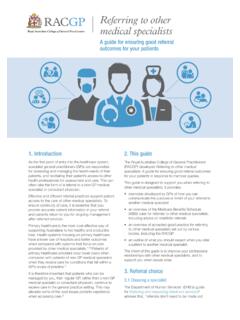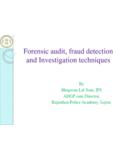Transcription of WHO | Medical devices
1 Medical DEVICEREGULATIONSG lobal overview andguiding principlesWORLD HEALTH ORGANIZATIONGENEVADEPARTMENT OF BLOOD SAFETY AND CLINICAL TECHNOLOGYWORLD HEALTH ORGANIZATION1211 GENEVA 27 SWITZERLANDFax41 22 791 4836E-mail 4 154618 2 HEALTHCARE TECHNOLOGY LIFE CYCLEDe-commissioningMaintenanceTraining OperationTechnology assessmentEvaluationPlanningProcurementI nstallationCommissioningAssessment of needsResearchDevelopmentTestingManufactu reMarketingTransferDistributionACQUISITI ONUTILISATIONPROVISIONMEDICAL DEVICEREGULATIONSG lobal overview andguiding principlesWORLD HEALTH ORGANIZATIONGENEVAA cknowledgementsThis guide was prepared under the principal authorship of Dr Michael Cheng.
2 It is basedon a similar publication issued by the Pan American Health Organization (PAHO) in1999 that reviewed the Canadian Medical devices Regulatory comments and suggestions made by members of the Global Harmonization TaskForce and those of many other reviewers are gratefully Department of Blood Safety and Clinical Technology thanks the Governments ofItaly and Luxembourg for their continued support to its work on Medical devices . World Health Organization 2003 All rights designations employed and the presentation of the material in this publication do not imply the expressionof any opinion whatsoever on the part of the World Health Organization concerning the legal status of anycountry, territory, city or area or of its authorities, or concerning the delimitation of its frontiers or mention of specific organizations.
3 Companies or products does not imply that they are endorsed orrecommended by the World Health Organization in preference to others of a similar nature that are notmentioned. Errors and omissions excepted, the names of proprietary products are distinguished by initialcapital the World Health Organization nor the principal author warrant that the information contained inthis publication is complete and correct and shall not be liable for any damages incurred as a result of its of the World Health Organization can be obtained from Marketing and Dissemination, WorldHealth Organization, 20 Avenue Appia, 1211 Geneva 27, Switzerland (Fax: +41 22 791 4857.)
4 Requests for permission to reproduce or translate WHO publications whether forsale or for noncommercial distribution should be addressed to Publications, at the above address (fax: +4122 791 4806; email: by minimum graphicsPrinted in FranceWHO Library Cataloguing-in-Publication DataWorld Health device regulations : global overview and guiding and supplies legislation and supplies standards making management control 92 4 154618 2(NLM Classification: WA 26)ContentsiiiForewordvGlossaryviiNote on the definition of Medical devicesviiChapter 1.)
5 Introduction1 Chapter 2. Medical device Medical device safety and risk Effectiveness/performance of Medical Phases in the life span of a Medical Participants in ensuring the safety of Medical The role of each Shared responsibility for Medical device safety and performance8 Chapter 3. Governmental regulation of Medical Critical elements for regulatory Stages of regulatory A common framework for Medical device Regulatory tools and general Product Vendor establishment Post-market Quality system requirements13 Chapter 4.
6 Global Harmonization Task Force (GHTF) Scope of the four GHTF study Benefits of the Final documents from the Global Medical Device Nomenclature (GMDN)17 Chapter 5. What are standards? Why do we need standards? Voluntary and mandatory Standards development Conformity assessment with National and international standards Identification of Current trends in the use of standards in Medical device regulations 22 Chapter 6. Optimizing the use of regulatory Increasing knowledge of the Medical device sector24ivMEDICAL DEVICE Establishing basic regulatory Basic Sharing problem Drafting a comprehensive policy or guideline on Medical Advantages of a national Classification of Medical Medical device product Product representation Vendor establishment The control of home-use, refurbished.
7 And donated The re-use of Medical devices that are labelled for single use Post-market Recognition and use of established national orinternational Promoting compliance and Setting priorities for regulatory programme Cautions in interpreting Medical device export certificates 34 Chapter 7. Priorities on the international agenda36 Annex for Medical device information37 Annex documents of the GHTF as they relate to the CommonRegulatory Framework40 Annex between ISO9001:1994 and ISO13485:199641 Annex moire for National Medical Device Administrations42 ForewordvThe term Medical devices covers a vast range of equipment, from simple tongue depressorsto haemodialysis machines.
8 Like medicines and other health technologies, they are essentialfor patient care at the bedside, at the rural health clinic or at the large, devices also cost governments a substantial amount of money. In 2000, theestimated one and a half million different Medical devices available on the marketrepresented over US$145 billion. With innovation and the rapid advancement oftechnologies, Medical devices are currently one of the fastest growing industries, and theglobal market figure for 2006 is expected to exceed US$260 many countries lack access to high-quality devices and equipment that areappropriate for their specific epidemiological needs.
9 This is particularly true in developingcountries, where health technology assessments are rare and where little regulatory controlsexist to prevent the importation or use of substandard devices . With the vast majority ofdevices in developing countries being imported, this leaves them prey to unscrupulousmarket influences and puts patients lives at need to put in place policies that will address all elements related tomedical devices , ranging from access to high quality, affordable products, through totheir safe and appropriate use and disposal.
10 The health technology life cycle diagram(back cover) illustrates the policy process that needs to be in place. However, policies willbe unsuccessful unless they are translated into national regulations that are enforced bylegislation and correlating sanctions, and that form an integral part of the overall nationalhealth , regulatory controls for Medical devices are scarce in the developing world,even though implementation of national Medical device regulations will often address thevery issues raised in countries as major concerns for patient safety.
















